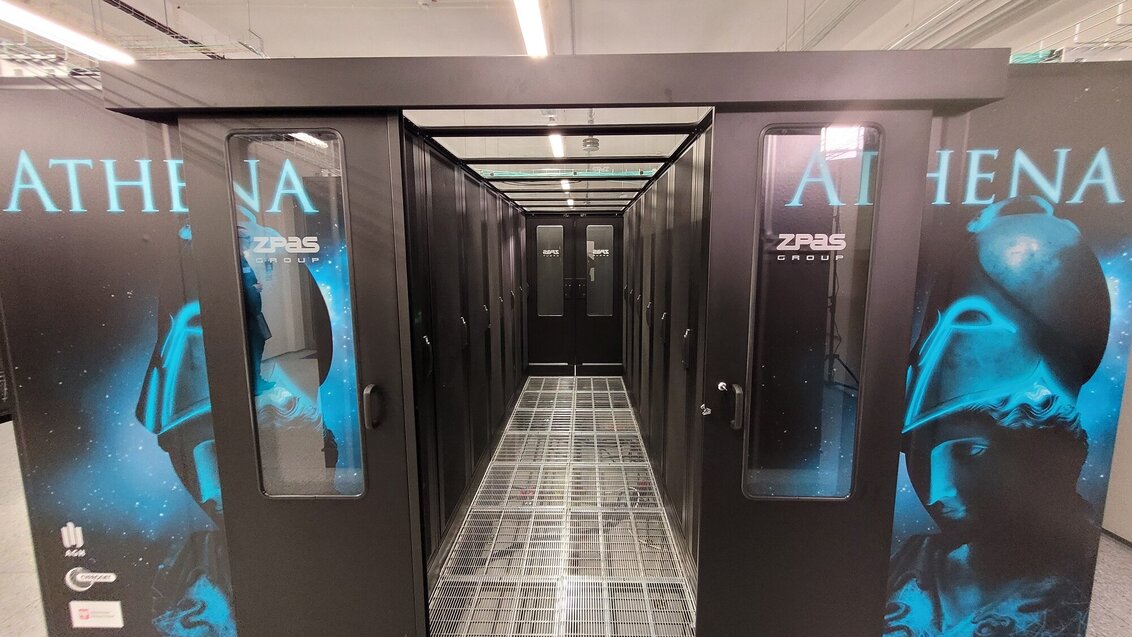Its theoretical computing power is more than 7.7 PFlops. Currently, it is the fastest and most eco-friendly supercomputer in Poland. Its name is Athena, and on October 4, 2022, it was officially launched at the Academic Computer Centre CYFRONET.
In the most recent TOP500 list of supercomputers with the greatest computing power in the world, Athena was ranked at a very high 105th place. Moreover, it came 9th in the Green500 ranking of the most environmentally friendly supercomputers. It had been installed at CYFRONET in 2021.
The AGH UST Academic Computer Centre CYFRONET supports Polish scientists by providing world-class resources and IT solutions. Essentially, these include three supercomputers: Athena (7.7 PFlops), Ares (3.5 PFlops), and Prometheus (2.7 PFlops). They have all made it to the prestigious list of the TOP500 fastest supercomputers in the world – this is the first time that three supercomputers from one Polish computer centre have made it to the ranking simultaneously. Additionally, they are all currently on the Green500 list of the most eco-friendly supercomputers.
At CYFRONET, supercomputers are used by Polish scientists in virtually all fields of science and innovative economy. In 2021, for the needs of scientific research, they have performed 5,549,582 computing tasks with a total duration of 43,409 years!
Professor Kazimierz Wiatr, Director of Academic Computer Centre CYFRONET, explains:
Polish science and innovative economy really need our supercomputers. Sometimes people ask me whether one supercomputer is not enough? The answer is simple: firstly, the needs of users are enormous; secondly, each supercomputer has its specific purposes that stem from its architecture, the CPU it has, and the main memory architecture. The Athena supercomputer that we are launching today gets its computing power from GPGPU units. These are modern and extremely efficient Ampere A100 SXM3 graphics processing units from Nvidia. Athena’s architecture is intended primarily for artificial intelligence calculations as well as medical applications, including the eradication of the COVID-19 pandemic.
An integral part that facilitates the use of such substantial computing power in an effective way is to provide the supercomputer with a high-performance internal network (Infiniband HDR with a bandwidth of 4 x 200 Gb/s per server) and a high-speed disk subsystem. It is built on the basis of open-source software, which was also used in the disk systems of the Prometheus and Zeus supercomputers, and dedicated disk servers. The system was installed at a CYFRONET data centre and integrated with the PLGrid network (Polish Infrastructure for Supporting Computational Science in the European Research Space).
This type of infrastructure meets the needs of users of CYFRONET supercomputers, who use the available computing power to perform high-performance scientific simulations, including the application of artificial intelligence and machine learning methods for various research projects in the fields of medicine, pharmacology, biology, chemistry, physics, and many other areas of science. Athena's computing power for AI computing is almost 240 PFlops!
The anticipated effects of delivering Athena’s specialised computing resources are the expansion of research work, the possibility of performing even more advanced simulations and analyses, and the increase in the possibilities of processing continuously incoming data from laboratories around the world. The direct anticipated results of the work include articles and research papers, patents, and innovative solutions for the innovative economy.

 Pre-election meeting with a candidate for the position of rector
Pre-election meeting with a candidate for the position of rector  Agreement on cooperation with OPAL-RT
Agreement on cooperation with OPAL-RT  Krakow DIANA Accelerator consortium members with an agreement
Krakow DIANA Accelerator consortium members with an agreement  Meeting with the Consul General of Germany
Meeting with the Consul General of Germany  More Academic Sports Championships finals with medals for our students
More Academic Sports Championships finals with medals for our students  Bronze for our swimmers at Academic Championships
Bronze for our swimmers at Academic Championships  Smart mountains. AGH University scholar develops an intelligent mountain rescue aid system
Smart mountains. AGH University scholar develops an intelligent mountain rescue aid system